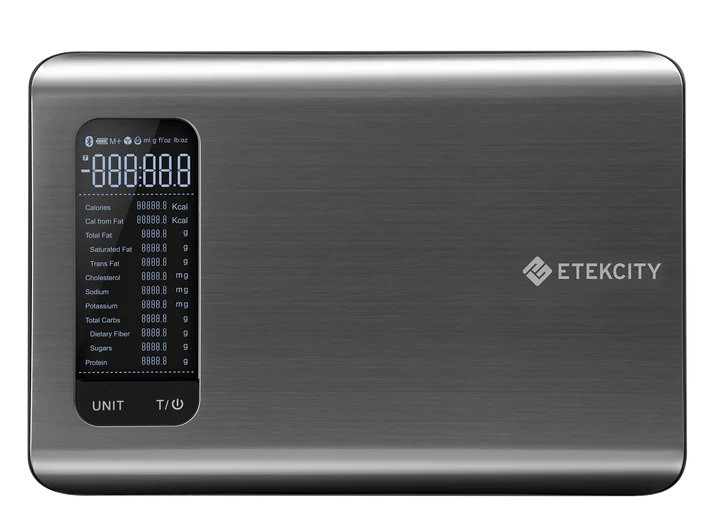
The modern kitchen has evolved beyond basic appliances into an interconnected hub of smart Gadgets that enhance cooking precision, efficiency, and convenience.
Smart kitchen technology integrates artificial intelligence, sensors, and connectivity to transform cooking processes. From precision cooking controls to automated inventory management, these innovations help reduce cooking errors, save time, and improve consistency.
This comprehensive guide explores ten transformative smart kitchen technologies, from precision cooking tools to automated storage systems. For each kitchen gadgets, you’ll discover real-world applications and practical benefits.
Whether you’re interested in basic automation or creating a fully connected kitchen, this guide covers essential solutions like smart thermometers, AI-powered ovens, voice-controlled assistants, and Smart Refrigerators. Each section provides concrete examples of how these technologies can improve your cooking experience and kitchen efficiency.
Table of Contents
1. Smart Thermometers and Precision Cookers
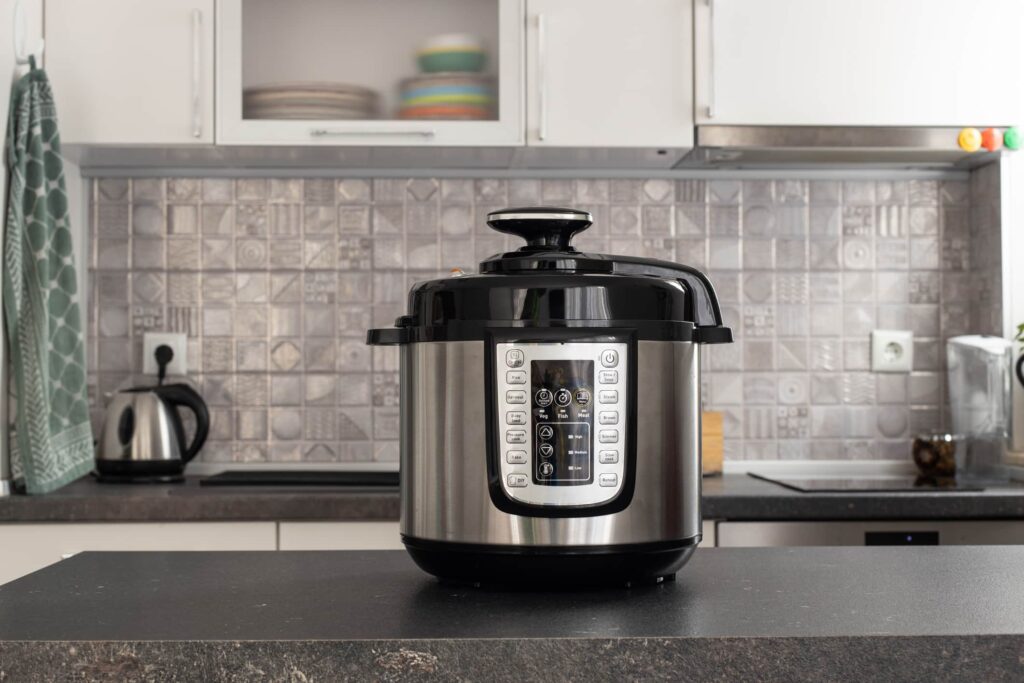
Smart thermometers and precision cookers have revolutionized temperature control in modern kitchens. These smart devices combine wireless connectivity with accurate temperature monitoring to ensure consistent results, whether smoking a brisket or sous viding a steak.
The technology behind these devices has evolved significantly, offering features like multiple probe monitoring, wireless connectivity, and automated cooking programs. Most modern units can send real-time alerts to your smartphone, allowing you to monitor cooking progress from anywhere in your home or even remotely. This capability transforms how we approach cooking, especially for longer cooking processes or precision-required dishes.
These smart devices have become particularly valuable for home cooks and professionals, offering precision previously available only in commercial kitchens. The integration of cloud connectivity means you can start, monitor, and adjust cooking processes from anywhere, while built-in safety features prevent overcooking and maintain food safety standards.
Benefits
- Energy Efficiency: Optimizes cooking times by maintaining exact temperatures throughout the cooking process, reducing energy waste from unnecessary extended cooking times.
- Professional Results: Achieves restaurant-quality results at home, reducing the need for dining out.
- Learning Capability: Records successful cooking sessions and helps replicate perfect results in future attempts. Creates a personalized cooking database based on your preferences.
- Food Safety: Ensures proper cooking temperatures are reached and maintained for food safety. Eliminates guesswork in determining when food is safely cooked.
- Nutrient Preservation: Maintains optimal cooking temperatures to preserve nutrients and flavors.
- Special Diets: Provides precise control needed for special dietary requirements and restrictions. Ensures consistent results for those with specific nutritional needs.
Real-World Applications
Home Cooking Applications:
- Baking perfect artisan bread with precise internal temperature monitoring
- Making homemade tofu with exact water temperature control
- Preparing tempeh with consistent fermentation temperature
- Creating perfectly cooked vegetable soups and stews
- Monitoring temperature for kombucha brewing
Professional Use:
- Managing multiple baking projects in a vegan bakery
- Temperature control for plant-based cheese-making
- Large-scale vegetable fermentation projects
- Catering event temperature management
- Commercial kitchen compliance monitoring
2. Smart Food Scales with Nutrition Trackers
Smart scales have transformed from simple weighing devices into comprehensive nutrition management systems. These Smart scales instantly calculate nutritional information while weighing ingredients. This dual functionality makes them invaluable for health-conscious cooking and precise recipe execution. The integration with recipe apps and nutrition databases has made them essential tools for both home cooks and professional chefs.
Modern smart scales use advanced load cell technology combined with extensive food databases to provide accurate nutritional information in real-time. The ability to sync with fitness apps and meal planning platforms creates a seamless experience for those tracking their nutrition or following specific dietary requirements. This technology has particularly revolutionized baking, where precise measurements are crucial for success.
The latest models include features like recipe scaling, multiple user profiles, and ingredient substitution suggestions. These capabilities make them particularly valuable for meal prep, recipe development, and dietary management. The integration with smart kitchen ecosystems means they can communicate with other devices to create a more streamlined cooking
Benefits
- Precise Portions: Measures exact serving sizes for better portion control and dietary management.
- Nutritional Tracking: Automatically calculates and records nutritional information for ingredients and meals. Syncs data with health and fitness apps for comprehensive tracking.
- Recipe Accuracy: Ensures perfect measurements for consistent recipe results every time.
- Scale Flexibility: Scale recipes automatically for any serving size.
- Quick Conversion: Instantly changes between various measurement units and portion sizes. This eliminates the need for laborious calculations.
- Recipe Integration: Connects directly with recipe apps to guide ingredient additions step-by-step.
- Efficiency Gains: Reduces prep time by combining measuring and tracking into one step. Streamlines the cooking process with automated measurement recording.
Real-World Applications
Daily Meal Preparation:
- Measuring precise portions for meal prep containers
- Calculating nutritional content for homemade granola
- Portioning ingredients for bulk cooking of lentil dishes
- Tracking protein intake in plant-based diets
- Measuring exact quantities for veggie burger recipes
Recipe Development:
- Creating new vegan baking recipes
- Developing plant-based cheese alternatives
- Scaling recipes for dinner parties
- Documenting successful recipe modifications
- Planning balanced vegetarian meal plans
3. Smart Connected Coffee Makers and Beverage Systems
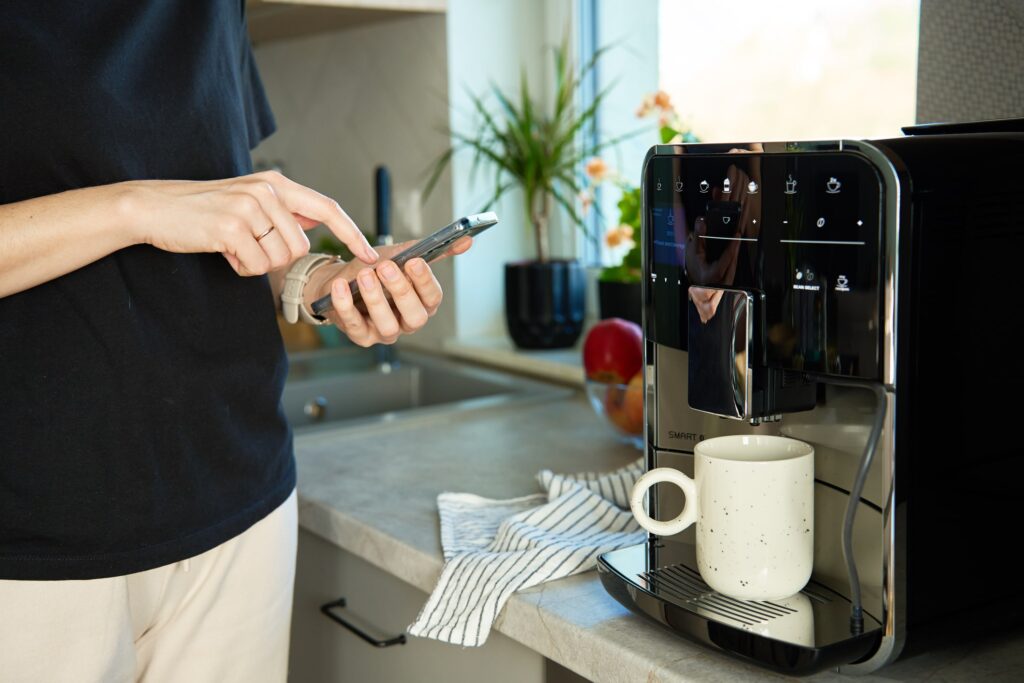
Smart coffee makers represent the perfect blend of convenience and customization in modern kitchen technology. These systems go beyond simple brewing to offer personalized drink profiles, maintenance tracking, and integration with smart home routines. The ability to schedule brewing times and control parameters remotely has made morning routines more efficient for millions of users.
Advanced models use precision temperature control and custom brewing algorithms to extract optimal flavor from different coffee beans. Many systems now include built-in grinders with automatic adjustment capabilities, ensuring the perfect grind size for each brewing method. The integration of milk frothing systems and customizable drink recipes brings barista-quality beverages into the home.
These machines often incorporate predictive maintenance features and automatic supply reordering, ensuring you never run out of coffee or face unexpected equipment issues. The ability to save and share drink recipes across users has created a community aspect of home coffee making. At the same time, integration with voice assistants enables hands-free operation during busy mornings.
Benefits
- Morning Automation: Prepares coffee to match your wake-up schedule perfectly. Ensures hot, fresh coffee is ready when you start your day.
- Custom Programming: Stores individual preferences for multiple household members. Automatically adjusts brewing parameters for each user’s perfect cup.
- Remote Control: Enables brewing initiation from anywhere through smartphone apps. Allows schedule adjustments without being in the kitchen.
- Temperature Precision: Maintains optimal brewing temperature for maximum flavor extraction. Ensures consistent quality across every brewing cycle.
- Customization Options: Adjusts brewing strength, temperature, and volume to match preferences. Creates barista-quality drinks customized to individual tastes.
- Resource Optimization: Measures precise amounts of coffee and water to prevent waste. Tracks usage patterns to optimize resource consumption.
- Maintenance Tracking: Provides timely maintenance reminders to extend machine life. Prevents costly repairs through proactive care.
- Cost Comparison: Reduces expensive coffee shop visits by providing café-quality drinks at home.
Real-World Applications
Daily Use:
- Scheduling morning coffee with perfect milk frothing
- Preparing tea with precise milk temperature control
- Creating perfect cappuccinos and lattes
- Making hot chocolate with whole milk
Entertaining:
- Preparing multiple coffee drinks for dinner parties
- Creating signature non-alcoholic beverages
- Serving different tea varieties at optimal temperatures
- Making smoothies with precise ingredient ratios
4. Smart Ovens
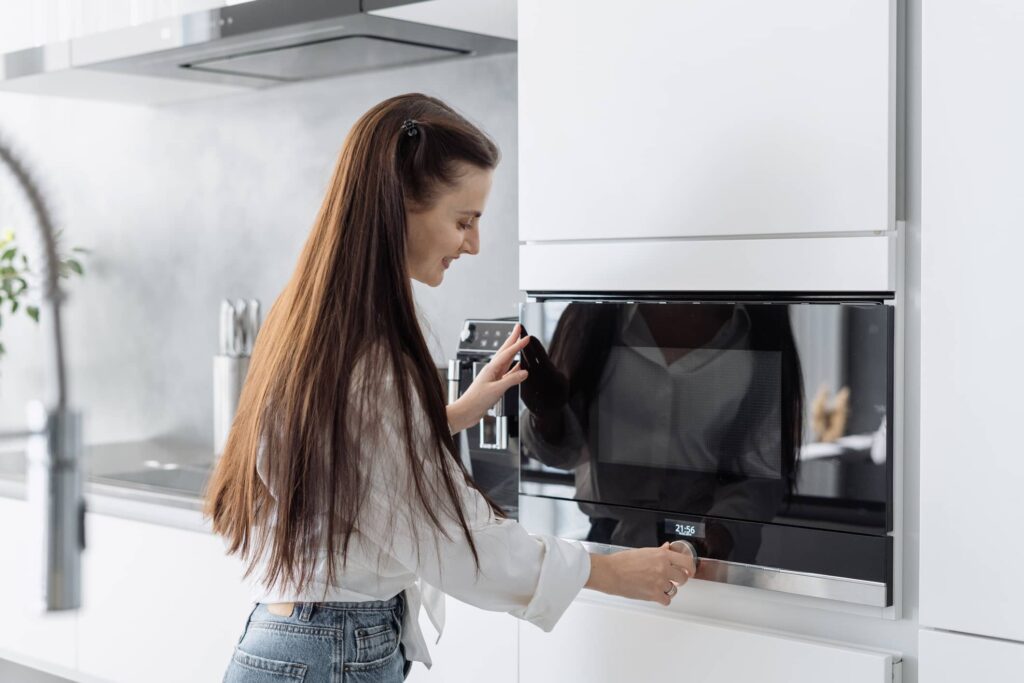
Smart ovens have revolutionized home cooking by combining multiple cooking technologies with AI-driven temperature control. These appliances use advanced sensors and cameras to identify foods and automatically adjust cooking parameters. The integration of mobile apps and cloud-based recipe platforms has made complex cooking techniques accessible to home cooks of all skill levels.
These systems excel at multi-stage cooking, automatically adjusting between different cooking methods as needed. For example, they might start with high heat for searing, then reduce to the perfect temperature for cooking through, and finally adjust for browning. This level of precision and automation has transformed how people approach cooking, making it more accessible and consistent.
The latest models include features like in-oven cameras that allow real-time monitoring of food through smartphone apps. Combined with precise temperature control and cooking programs, these features help prevent burning and ensure perfect results. Many units also track energy usage and suggest optimal cooking times based on your preferences and past cooking history.
Benefits
- Temperature Precision: Maintains exact temperatures throughout cooking with multiple sensor points.
- Multi-Stage Cooking: Executes complex cooking sequences automatically with precise timing.
- Create an ideal cooking environment for each dish type.
- Remote Preparation: Preheat the oven remotely before arriving home.
- Smart Timing: Calculates optimal cooking times based on food type and desired results. Adjusts timing automatically for different quantities.
- Temperature Monitoring: Constantly tracks cooking temperatures and alerts to any issues. Prevents overheating and potential fire hazards.
- Auto Shutdown: Includes automatic shutoff features when cooking is complete or issues are detected.
Real-World Applications
Daily Cooking:
- Roasting vegetables with perfect crispiness through moisture sensing
- Baking sourdough bread with precise temperature control
- Making granola with even browning monitoring
- Preparing multiple sheet pans of roasted vegetables
- Dehydrating fruits and vegetables for snacks
Advanced Techniques:
- Creating perfect pizza with stone temperature monitoring
- Fermenting vegetables with low-temperature control
- Baking delicate pastries with humidity control
- Making yogurt with precise temperature maintenance
- Proofing bread dough in a controlled environment
5. Automated Mixers and Food Processors
Modern smart mixers and food processors combine traditional mixing power with intelligent programming and precise control systems. These devices have evolved from simple mixing tools into comprehensive food preparation stations that can handle everything from gentle folding to vigorous kneading. The integration of weight sensors, temperature monitors, and speed controls ensures consistent results across all types of food preparation.
The latest generation of these devices includes features like ingredient recognition and automatic program adjustment. They can detect when the cream has been properly whipped, the dough has been sufficiently kneaded, or the butter has reached the perfect creaming stage. This level of automation has made complex recipes more accessible while ensuring consistent results.
Smart mixers and processors now integrate with recipe platforms to provide step-by-step guidance and automatic settings adjustment. Many models can even scale recipes automatically and adjust mixing parameters based on ingredient quantities. This technology has particularly transformed baking, where precise mixing times and techniques are crucial for success.
Benefits
- Consistency Control: Monitors and adjusts mixing speed based on ingredient resistance. Ensures perfect texture every time for doughs, batters, and other mixtures.
- Temperature Management: Tracks and maintains optimal temperature during mixing processes. Prevents overheating of ingredients and ensures proper development of doughs.
- Intelligent Adjustment: Automatically modifies mixing patterns based on recipe requirements. Adapts to different ingredients and quantities without manual intervention.
- Hands-Free Operation: Completes mixing tasks without constant supervision.
- Multi-Task Capability: Handles complex mixing sequences while monitoring consistency and temperature.
- Recipe Replication: Stores successful mixing sequences for perfect reproduction later. Ensures consistent results across multiple batches.
- Ingredient Integration: Track ingredient additions automatically. Prevents under-mixing or over-mixing issues.
Real-World Applications
Basic Food Prep:
- Making butter-based cookie dough with perfect texture
- Creating smooth cream cheese frostings
- Preparing homemade butter from cream
- Mixing perfect pancake batter with buttermilk
- Whipping cream for desserts
Advanced Applications:
- Developing smooth cheese spreads
- Creating creamy vegetable soups with dairy
- Making the perfect ice cream base
- Preparing homemade ricotta
- Processing cheese-based dips and spreads
6. Voice-Controlled Kitchen Assistants
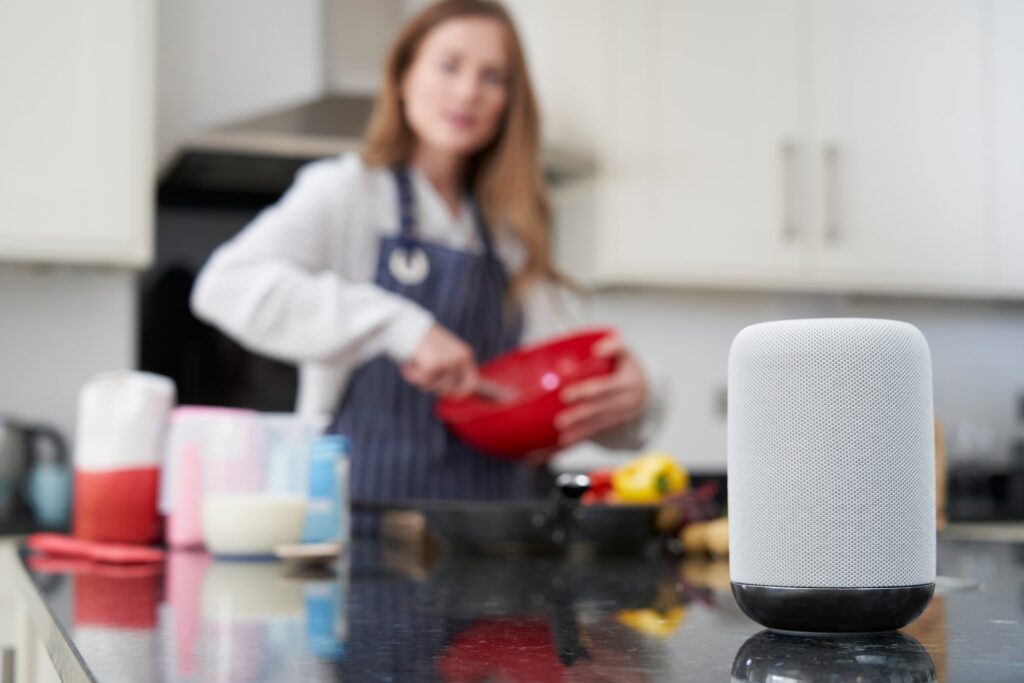
Voice-controlled kitchen assistants have transformed from simple timer-setting tools into comprehensive cooking companions. These systems understand context-specific commands and can simultaneously manage multiple aspects of your cooking process. The integration with other smart kitchen devices enables hands-free control of everything from ovens to coffee makers, making cooking more efficient and enjoyable.
Natural language processing has made these assistants increasingly intuitive, allowing them to understand casual commands and context-based requests. Rather than requiring specific phrases, they can interpret requests like “Check if the chicken is done” or “What’s the next step in the recipe?” This natural interaction is particularly valuable when hands are messy or occupied with cooking tasks.
Advanced systems now coordinate with multiple smart kitchen devices simultaneously. When you’re preparing a complex meal, the assistant can monitor oven temperature, adjust cooking times based on actual progress, and even coordinate the timing of different dishes to ensure everything finishes at the same time. This orchestration capability transforms complex meal preparation into a more manageable process.
The latest generation of kitchen assistants includes visual displays that complement voice control. These screens can show recipe steps, cooking videos, or real-time feeds from your smart appliances, providing visual confirmation of voice commands. This multi-modal approach ensures you always have the necessary information in the most appropriate format.
Benefits
- Hands-Free Control: Control kitchen devices hands-free while cooking.
- Multi-Device Management: Controls multiple kitchen appliances through simple voice commands. Coordinates different devices for complex cooking tasks.
- Timer Coordination: Manages multiple timers and cooking stages simultaneously. Provides clear audio feedback for different timing needs.
- Emergency Response: Enables immediate hands-free calling for help in case of accidents. Provides quick access to emergency services when needed.
- Equipment Monitoring: Tracks appliance status and alerts to potential safety issues. It helps prevent accidents through proactive monitoring.
- Shopping Management: Create shopping lists through voice commands. Tracks inventory and needed items in real-time.
- Recipe Navigation: Provides hands-free access to recipes and cooking instructions. Guides through complex recipes step by step.
Real-World Applications
Daily Tasks:
- Managing multiple timers for cheese making
- Converting measurements for dairy-based recipes
- Looking up cheese substitutions
- Controlling temperature for milk pasteurization
- Adding dairy products to shopping lists
Recipe Management:
- Following complex baking instructions hands-free
- Managing cheese aging schedules
- Coordinating multiple dish preparation timing
- Recording successful dairy recipe modifications
- Creating shopping lists for cheese making supplies
7. Smart Connected Dishwashers
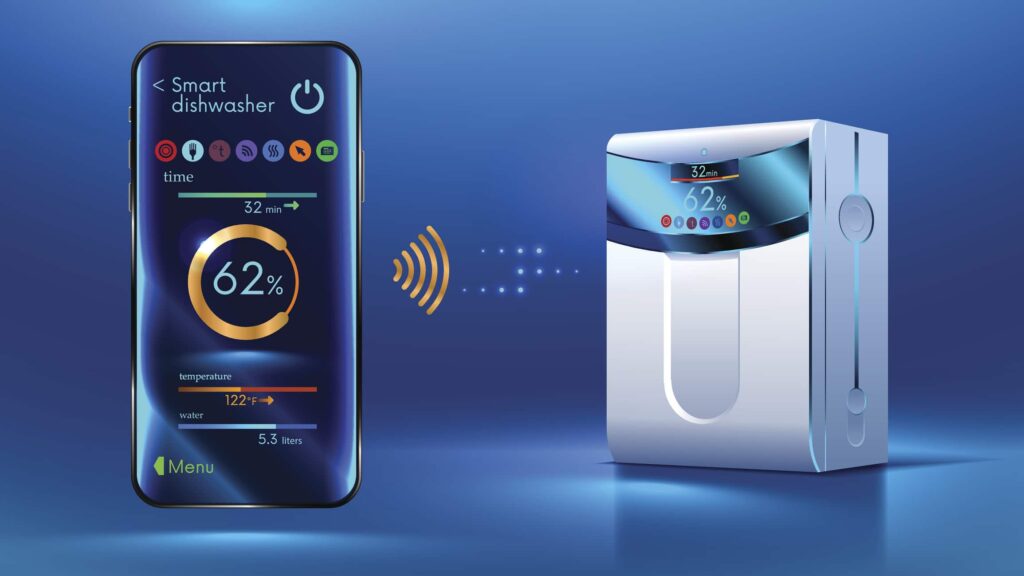
Connected dishwashers have evolved from basic cleaning appliances into sophisticated systems that optimize water usage, detergent dispensing, and cleaning cycles. These machines use advanced sensors and AI algorithms to detect soil levels, adjust water pressure and temperature, and modify cycle duration to achieve optimal cleaning while minimizing resource consumption.
Mobile connectivity has transformed how we interact with these appliances. Through smartphone apps, users can monitor cleaning progress, receive notifications, and troubleshoot problems before they require expensive repairs. This connectivity also enables smart features like delayed start during off-peak energy hours and cycle completion notifications.
Modern dishwashers now incorporate water quality sensors that adjust cleaning parameters based on local water conditions. These systems modify detergent dispensing and rinse cycles to prevent spotting and mineral buildup, ensuring consistently clean results regardless of water hardness or mineral content.
Benefits
- Resource Optimization: Adjusts water and energy usage based on load size and soil level. Reduces utility costs while maintaining cleaning effectiveness.
- Cycle Management: Select optimal cleaning cycles based on the detection of dish type and soil level. Ensures thorough cleaning while minimizing resource usage.
- Smart Scheduling: Operates during off-peak hours to reduce energy costs.
- Cleaning Customization: Adapts water pressure and temperature for different types of loads. Ensures optimal cleaning for everything from delicate glassware to heavily soiled pots.
- Quality Monitoring: Tracks cleaning performance and alerts to any issues affecting results. Suggests maintenance or adjustments to improve cleaning effectiveness.
- Water Quality Management: Adjusts cleaning parameters based on water hardness and mineral content.
Real-World Applications
Daily Use:
- Cleaning cheese making equipment and molds
- Managing dairy-coated cooking vessels
- Handling delicate yogurt making equipment
- Cleaning baking dishes with cheese residue
- Sanitizing milk processing equipment
Professional Applications:
- Managing equipment for vegetarian catering services
- Cleaning high-volume ice cream making tools
- Handling commercial baking equipment
- Sanitizing cheese making vessels
- Processing dairy preparation containers
8. Smart Refrigerators with Food Management
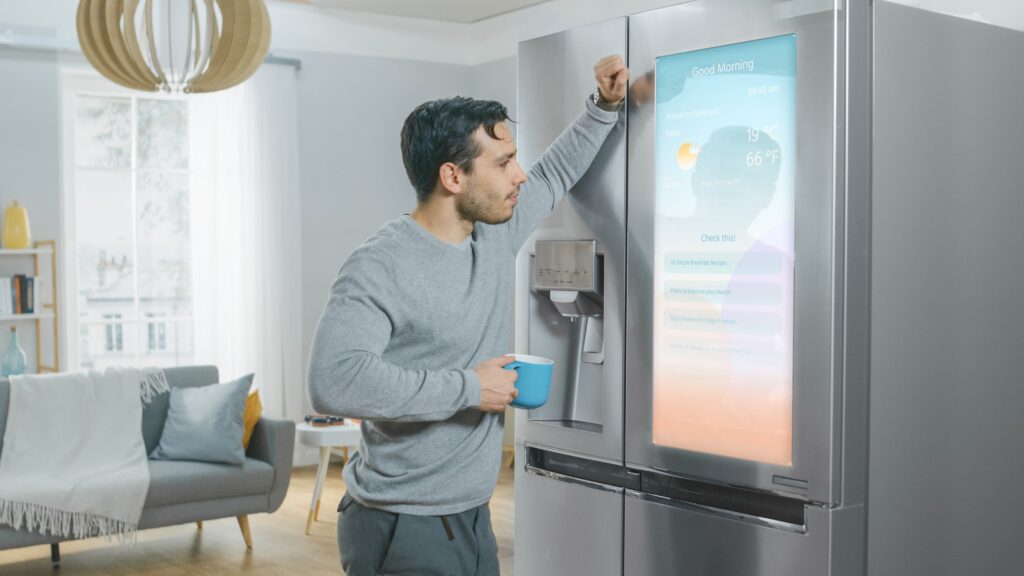
Modern smart refrigerators serve as the command center of the connected kitchen, combining sophisticated food storage with intelligent management systems. These appliances use internal cameras, weight sensors, and environmental controls to maintain optimal conditions for different types of food while providing real-time inventory tracking and freshness monitoring.
The integration of AI-powered cameras has revolutionized how we track our food inventory. These systems can identify different food items, monitor their freshness status, and even suggest recipes based on what’s available. When viewing the contents remotely through your smartphone, the AI can highlight items nearing expiration and suggest meal plans that prioritize their use.
Temperature management in smart refrigerators has become incredibly sophisticated, with multiple cooling zones that can be independently controlled. Some models offer customizable temperature presets for specific foods like wine, cheese, or fresh produce. These systems continuously monitor and adjust conditions to maintain optimal freshness, even accounting for door openings and ambient kitchen temperature changes.
Benefits
- Inventory Management: Tracks stored items through internal cameras and sensors. Alerts when items are running low or approaching expiration.
- Zone Control: Maintains optimal temperature in different compartments for various food types. Extends food freshness through precise temperature management.
- Usage Optimization: Learns family patterns to adjust cooling during peak and low-use periods. Adjust cooling based on usage patterns.
- Performance Monitoring: Tracks system efficiency and alerts to potential issues. It helps prevent energy waste from poor seals or mechanical problems.
- Schedule maintenance automatically.
Real-World Applications
Food Storage:
- Monitoring optimal temperature for different produce types
- Tracking the freshness of milk and cream
- Tracking the ripeness of fruits and vegetables
- Managing humidity for cheese storage and leafy greens
- Organizing different temperature zones for dairy
Meal Planning:
- Suggesting recipes based on available products
- Tracking seasonal vegetable inventory
- Organizing milk-based desserts
- Monitoring prepared meal components
9. Future-Proof Kitchen Integration Systems
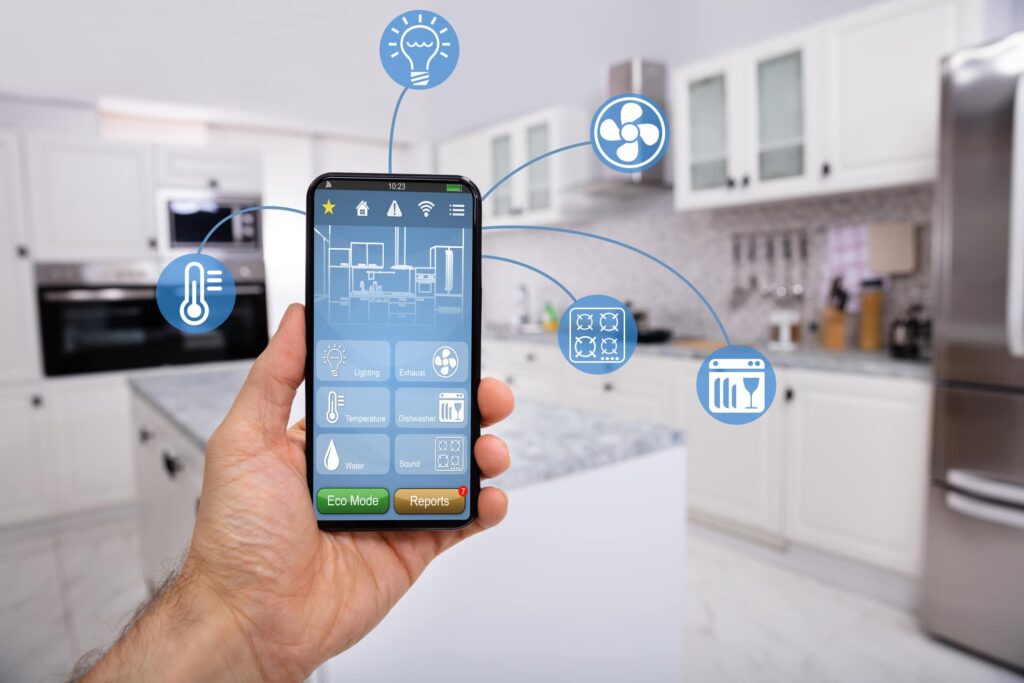
Future-proof kitchen integration systems create a cohesive, interconnected cooking environment where devices work together seamlessly. These systems serve as the central nervous system of your kitchen, coordinating multiple devices and appliances while ensuring compatibility with future technologies through standardized protocols like Matter and Thread.
Network infrastructure forms the backbone of these systems, with dedicated hubs managing communication between devices from different manufacturers. Unlike early smart kitchen solutions that often worked in isolation, modern systems ensure long-term compatibility and easy expansion. This standardization means your investment in smart kitchen technology remains valuable as new innovations emerge.
The role of artificial intelligence continues to expand in these systems, with machine learning algorithms adapting to your cooking habits and preferences over time. The system learns from your daily routines, anticipating needs and automating common tasks while maintaining robust security features to protect your connected kitchen.
Benefits
- Universal Connection: Ensures new devices can integrate seamlessly with existing systems. Protects your investment as technology evolves.
- Protocol Support: Works with multiple communication standards for broader device compatibility. Allows the mixing of different brands and technologies.
- Update Management: Receives regular software updates to maintain security and add features. Extends the useful life of your smart kitchen system.
- Sequence Creation: Builds complex automation routines across multiple devices. Coordinates different appliances for efficient cooking workflows.
- Pattern Learning: Adapts to your cooking habits and preferences over time. Creates personalized automation based on usage patterns.
- Resource Management: Coordinates device operation to optimize energy usage. Reduces overall utility costs through smart scheduling.
Real-World Applications
System Coordination:
- Synchronizing fermentation temperature monitoring
- Coordinating yogurt fermentation timing
- Coordinating sprouting and microgreen production
- Managing multiple preservation projects
- Automating seasonal cooking workflows
- Integrating garden harvest processing
Advanced Applications:
- Managing indoor herb garden systems
- Coordinating multiple cooking projects
- Automating kitchen garden watering
- Monitoring mushroom growing conditions
- Tracking long-term fermentation projects
10. Smart Ventilation with Air Quality Systems

Modern ventilation systems have evolved into comprehensive air quality management solutions that actively monitor and respond to cooking conditions. These systems use multiple sensors to detect cooking fumes, humidity, temperature, and air particulates, automatically adjusting ventilation strength to maintain optimal kitchen air quality.
The environmental impact of these systems is significant, with energy-efficient motors and smart controls that optimize power usage based on actual needs. Many systems now incorporate heat recovery technology, capturing warmth from exhaust air during winter months, while others include air purification features that remove cooking odors and harmful particles.
Integration with other kitchen devices creates coordinated responses to cooking activities. When your smart cooktop detects high-temperature cooking, the ventilation system automatically increases power to handle additional smoke and steam while maintaining optimal energy efficiency.
Benefits
- Automatic Detection: Senses cooking activities and adjusts ventilation levels automatically. Removes smoke, steam, and odors before they spread through the home.
- Environmental Control: Maintains optimal kitchen air quality through continuous monitoring and adjustment. It helps create a healthier cooking environment.
- Filter Management: Tracks filter condition and efficiency to maintain optimal air cleaning. Alerts when maintenance or replacement is needed.
- Smart Operation: Activates only when needed and adjusts power based on actual cooking conditions. Reduces unnecessary energy usage while maintaining effective ventilation.
- Heat Recovery: Captures and redistributes heat from cooking activities during cold weather. It helps maintain comfortable kitchen temperatures while reducing heating costs.
Real-World Applications
Cooking Activities:
- Managing steam from multiple pressure cookers
- Controlling humidity during mushroom cultivation
- Removing strong spice aromas during Indian cooking
Environmental Control:
- Maintaining optimal humidity for bread proofing
- Managing kitchen garden growing conditions
- Controlling temperature for chocolate work
- Maintaining optimal conditions for kombucha brewing
Conclusion
Smart kitchen technology has transformed from isolated gadgets into an interconnected ecosystem that enhances cooking precision, efficiency, and convenience. From basic temperature monitoring to advanced AI-powered cooking systems, these technologies offer practical solutions for both everyday cooking challenges and professional kitchen operations. The impact on cooking quality and kitchen management has made these tools increasingly essential for modern homes.
The integration capabilities between different devices create a seamless cooking environment where appliances communicate and coordinate actions. When choosing smart kitchen technologies, focus on devices that solve specific cooking challenges while offering compatibility with existing systems. Investment in standardized protocols like Matter ensures long-term value and future expandability.
These ten smart kitchen technologies represent current market solutions that deliver tangible benefits in cooking quality, time savings, and resource management. As technology continues to advance, smart kitchen devices will become increasingly accessible, making professional-grade cooking capabilities available to more home cooks while continuing to transform how we prepare and enjoy food.
Frequently Asked Questions (FAQs)
For most home cooks, I recommend starting with a smart scale with nutritional tracking. It’s an affordable entry point (typically $50-100) that immediately improves cooking precision and meal planning. A smart scale helps perfect recipe measurements, tracks nutritional information, and connects with recipe apps for easier cooking. Plus, it’s straightforward to use and provides immediate value in daily cooking tasks.
While some brands offer better integration within their ecosystem, many smart kitchen devices now support standard protocols like Matter or HomeKit. I recommend checking device compatibility with your existing smart home system before purchasing. Focus on devices that use widely-supported protocols rather than proprietary systems to ensure future flexibility and expansion options.
Maintenance is generally straightforward but requires attention to detail. Most devices need regular software updates, which usually happen automatically through their apps. Physical maintenance isn’t much different from traditional appliances – regular cleaning and basic care. I recommend keeping a simple maintenance calendar and responding promptly to update notifications to ensure optimal performance.
Yes, modern smart kitchen devices support multiple user profiles and preferences. Family members can create their own accounts with personalized settings, recipes, and preferences. Access levels can be customized, allowing parents to restrict certain features for children while maintaining full functionality for adults. I find this especially useful for families who cook together or have different dietary needs. reach your inbox on any platform.
Smart kitchen devices should be treated as part of your home network security. Use strong, unique passwords for each device and their associated apps. Enable two-factor authentication when available. Regularly update device firmware and apps to ensure security patches are current. I recommend creating a separate network for smart home devices if possible.
Smart kitchen appliances often reduce energy consumption through intelligent power management. They can schedule operations during off-peak hours, optimize cooking times, and automatically switch to energy-saving modes when not in use. My smart oven, for example, reduced my energy bills by precisely controlling temperature and cooking duration. However, the initial power draw might be slightly higher due to always-on features, but this is typically offset by efficiency gains.
